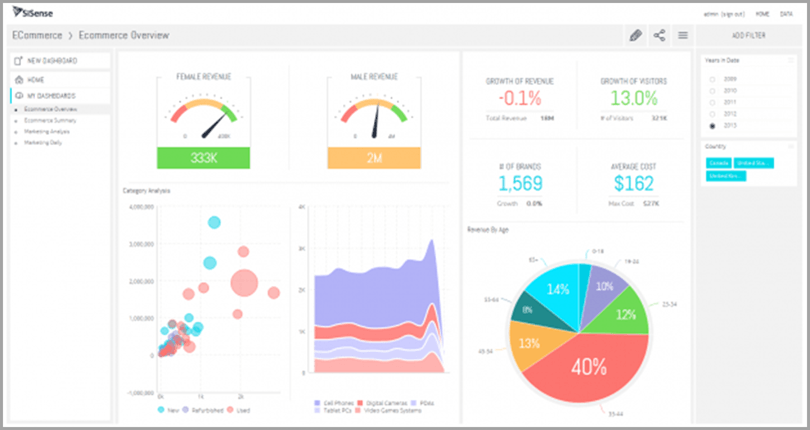
Get Ahead Using 12 Business Intelligence Tools For Data-Driven Results
In today’s fast-paced business landscape, data is king. Companies that can effectively harness the power of their data are the ones that thrive. This is where business intelligence (BI) tools come into play. They provide the insights needed to make informed decisions, optimize operations, and gain a competitive edge. This article explores twelve essential business intelligence tools that can help you achieve data-driven results and get ahead of the competition.
The journey toward data-driven results begins with the right tools. These tools help gather, analyze, and visualize data. The goal is to transform raw information into actionable intelligence. This intelligence empowers businesses to make better decisions. This leads to improved performance and profitability.
The Power of Business Intelligence
Business intelligence is more than just collecting data. It’s about understanding the story the data tells. It’s a crucial process for converting raw data into meaningful insights. This process allows businesses to identify trends, patterns, and anomalies. These insights are then used to inform strategic decisions. Effective BI implementation leads to significant improvements. These improvements include increased efficiency, reduced costs, and enhanced customer satisfaction. [See also: The Benefits of Business Intelligence in Today’s Market]
Essential Tools for Data-Driven Success
Here are twelve leading business intelligence tools, categorized by their primary function, to help you achieve data-driven results.
Data Visualization Tools
Data visualization tools transform complex data into easy-to-understand visual representations. These tools help users quickly grasp trends and patterns. They are instrumental in communicating findings to stakeholders.
- Tableau: A widely-used tool known for its intuitive interface and powerful visualization capabilities. Tableau supports a wide range of data sources.
- Power BI: Microsoft’s offering, Power BI, integrates seamlessly with other Microsoft products. It offers robust data modeling and visualization features.
- Qlik Sense: Qlik Sense is known for its associative data modeling. This allows users to explore data from multiple angles and uncover hidden insights.
Data Integration and ETL Tools
Extract, Transform, Load (ETL) tools are essential for preparing data for analysis. They gather data from various sources. They then clean, transform, and load it into a data warehouse or data lake.
- Informatica PowerCenter: A comprehensive ETL tool that supports complex data integration scenarios. It is used by large enterprises.
- Talend: Talend offers both open-source and commercial ETL solutions. It is known for its ease of use and data quality features.
- Apache NiFi: An open-source data flow system. Apache NiFi automates data movement and transformation.
Data Analysis and Reporting Tools
These tools are designed to analyze data and generate reports. They provide insights into business performance and trends.
- SAP BusinessObjects: A comprehensive BI suite that includes reporting, analysis, and dashboarding capabilities. It is often used in large organizations.
- IBM Cognos Analytics: Another enterprise-grade BI platform. IBM Cognos Analytics provides a wide range of analytical features.
- Looker: A modern BI platform that focuses on data exploration and collaboration. It allows users to create and share data insights.
Advanced Analytics and AI-Powered Tools
These tools leverage advanced analytics and artificial intelligence to uncover deeper insights and predict future trends.
- Alteryx: A platform for data science and analytics automation. Alteryx helps users prepare, blend, and analyze data.
- DataRobot: An automated machine learning platform. DataRobot simplifies the process of building and deploying predictive models.
- RapidMiner: A data science platform that offers both visual workflows and code-based options. RapidMiner supports a wide range of machine learning algorithms.
Choosing the Right Tools for Your Needs
Selecting the right business intelligence tools depends on several factors. These factors include your specific business needs, data sources, and technical expertise. Consider the following when making your decision:
- Data Sources: Ensure the tool supports your data sources. This includes databases, cloud services, and spreadsheets.
- Scalability: Choose a tool that can handle your current and future data volumes.
- User-Friendliness: Opt for tools with intuitive interfaces. This will facilitate user adoption.
- Features: Evaluate the features of each tool. Make sure they align with your analysis requirements.
- Cost: Consider the total cost of ownership. This includes licensing, implementation, and training.
Implementing Business Intelligence for Data-Driven Results
Implementing business intelligence effectively requires a strategic approach. This includes a well-defined plan and the right team. Here are some key steps:
- Define Objectives: Clearly define your business goals and the questions you want to answer.
- Assess Data Sources: Identify and assess your data sources. Determine data quality and accessibility.
- Choose Tools: Select the business intelligence tools that best fit your needs.
- Implement and Integrate: Implement the tools and integrate them with your data sources.
- Train Users: Provide training to your users. This will ensure effective use of the tools.
- Monitor and Refine: Continuously monitor your BI implementation. Refine your approach based on feedback and results.
The Future of Business Intelligence
The future of business intelligence is bright. Expect to see continued advancements in AI, machine learning, and automation. These advancements will make BI even more powerful and accessible. Businesses that embrace these innovations will be well-positioned. They will gain a significant competitive advantage. The goal is to achieve more data-driven results.
Conclusion: Embrace Data for Success
In conclusion, business intelligence tools are indispensable for achieving data-driven results. By leveraging the right tools and implementing a strategic approach, businesses can unlock the power of their data. They can make informed decisions, optimize operations, and gain a competitive edge. Embrace data, and you will be well on your way to success. The selection of the right business intelligence tools is a crucial first step. These tools enable the extraction of actionable insights. These insights are essential for achieving data-driven results.
Remember to continuously evaluate and adapt your BI strategy. This ensures you stay ahead in the ever-evolving business landscape. The ultimate goal is to use the power of data to drive positive change. This change is at the core of data-driven results.

